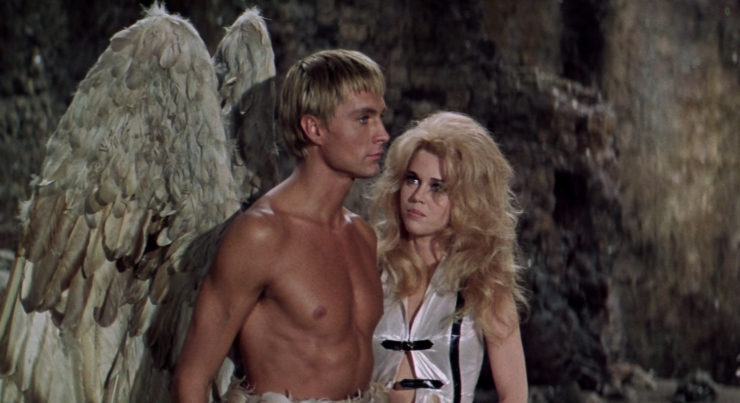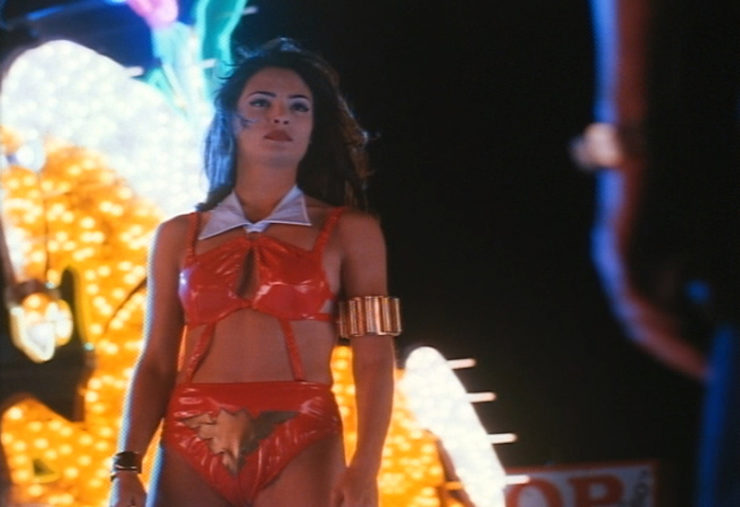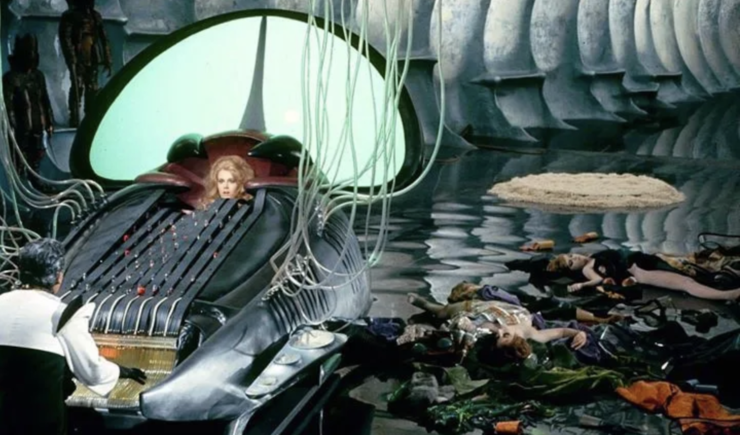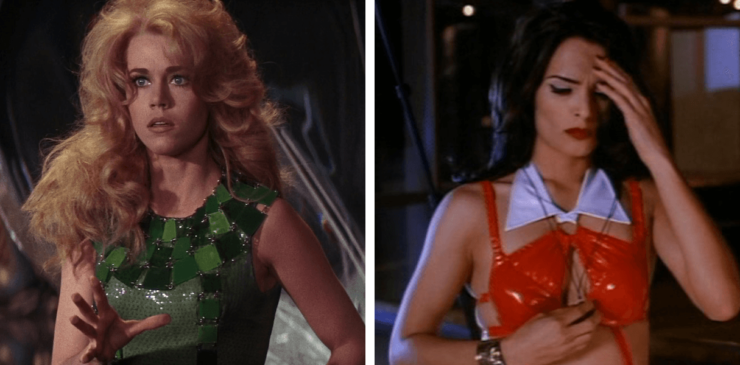From August 2017 – January 2020, Keith R.A. DeCandido covered nearly every live-action movie based on a superhero comic that had been made to date in the Superhero Movie Rewatch. He has been revisiting the feature every six months or so to look back at the new releases in the previous half-year, as well as a few he missed the first time through. We kick off this semi-annual look back with two twentieth-century movies…
Jean-Claude Forest created the character of Barbarella for V Magazine in 1962, chronicling the erotic tales of a far-future space pilot who traveled from planet to planet and had adventures, usually involving sex.
Seven years later, inspired in part by Forest’s character’s name, Forrest J. Ackerman conceived the character of Vampirella for Warren Comics, originally intended as the “host” of an anthology horror comic like Warren’s other titles Creepy (hosted by Uncle Creepy) and Eerie (hosted by Cousin Eerie), but Vampi also starred in her own adventures.
Both had movie adaptations made, one of which became a cult hit, one of which, um, didn’t.
When Forest’s serialized strips were collected into a graphic novel called, appropriately, Barbarella, it was something of a scandal, and was deemed pornographic. However, it was also hugely successful. Dino De Laurentiis acquired the film rights, hiring Terry Southern to adapt the comic for the screen and Roger Vadim to direct.
Several actors were approached to play the very heavily sexualized title role, including Brigitte Bardot (who refused because she no longer wished to play “sex kitten” parts), Sophia Loren (who declined due to being pregnant), and Raquel Welch (who decided to do Myra Breckenridge instead). Finally, Vadim cast his wife, Jane Fonda.
Southern’s script was heavily rewritten by Vadim, five other credited screenwriters, and at least one other uncredited writer (Charles B. Griffith). Several changes were made to the comic story, including making Barbarella an agent of the united Earth government rather than an outlaw. The movie also provided a new character as Barbarella’s target, and later antagonist, the scientist Durand Durand. (And yes, the band named themselves after the character, though they spelled it “Duran Duran,” as that’s how it was pronounced by everyone in the film.)
At Fonda’s recommendation, John Phillip Law was cast as Pygar, the blind winged “angel” who teams up with Barbarella. At Southern’s recommendation, Anita Pallenberg was cast as the Great Tyrant (a version of La Reine Noire from the comics, a.k.a. The Black Queen), but she was dubbed for the English-language version, either by Joan Greenwood or Fenella Fielding, depending on which source you believe. Dildano was originally played by Antonio Sabato, but he was replaced by David Hemmings because Sabato played the role too serious. And this film marks the speaking debut of famous mime Marcel Marceau, who plays Professor Ping. Rounding out the cast are Milo O’Shea as the Concierge, a.k.a. Durand Durand, Claude Dauphin as the President of Earth, and Ugo Tognazzi as Mark Hand.
Buy the Book


Wild Massive
Ackerman came up with the name of the character of Vampirella mainly as a portmanteau of “vampire” and “Barbarella.” Vampirella #1 came out just a year after the movie. Vampi quickly became the most popular character in Warren’s stable of black-and-white magazines throughout the 1970s.
Vampi’s path to a screen adaptation was much longer than Barbarella’s. Hammer Films had a movie in development in the late 1970s that was to star Peter Cushing, Orson Welles, and Donald Pleasance, with Caroline Munro, Barbara Leigh, and Valerie Leon among the actors being considered for the title role. Peter Guber and Jon Peters had the rights in the 1980s, and then the rights wound up with Roger Corman’s production company, and a Vampirella film was made as part of the Roger Corman Presents series of direct-to-cable movies on Showtime that ran from 1995-1997 (and which also included such gems as Black Scorpion, A Bucket of Blood, Bram Stoker’s Burial of the Rats, and other science fiction/horror flicks).
B-movie/exploitation film/soft-core porn maven Jim Wynorski was tapped to direct, seven years after he helmed The Return of Swamp Thing, and he hired his friend Gary Gerani, a self-avowed Vampirella fan, to write the script. Wynorski wanted either Paula Abdul or Julie Strain for the title role, but the studio insisted on casting former model Talisa Soto. Roger Daltrey, the frontman of The Who, and also a talented actor, was cast as the villain, Vlad Tepish, with Richard Joseph Paul as Adam Van Helsing, Lee de Broux as Walsh, Angus Scrimm as the High Elder, Brian Bloom as Demos, and David B. Katz as a young man Vampirella befriends when she arrives on Earth named Forry Ackerman (ahem).
Both movies intended to have near-immediate sequels. Producer Robert Evans had Barbarella Goes Down (which was to have Barbarella having adventures underwater, thus allowing for plausible deniability with regards to the double entendre title) in development a month after Barbarella’s release, while the closing credits of Vampirella teased a sequel subtitled Dark Avenger of Death. Neither came to pass. Several Barbarella sequels/remakes were greenlit (including one to be directed by Robert Rodriguez and starring Rose McGowan, and another starring Fonda’s niece Bridget), but none made it out of development hell.
Vampirella has continued to be a comics hit pretty much continuously for fifty years. After Warren went out of business, Harris Comics bought up their trademarks and released new Vampirella comics starting in 1991, which were at the vanguard of the “bad girl” movement in comics in the 1990s.
In the 2010s, Dynamite Comics took over both characters, acquiring Vampirella from Harris in 2010 and publishing Barbarella comics starting in 2017. Films featuring both characters are currently in development, with Sydney Sweeney producing and set to be starring in a new Barbarella movie, while Dynamite announced in March 2021 that a Vampirella film and several TV series were in the works.
“A good many dramatic situations begin with screaming”
Barbarella
Written by Terry Southern and Roger Vadim and Claude Brulé and Vittorio Bonicelli and Clement Biddle Wood and Brian Degas and Tudor Gates
Directed by Roger Vadim
Produced by Dino De Laurentiis
Original release date: October 11, 1968

On her spaceship Alpha 7, Barbarella removes her spacesuit in zero-G as a quasi-burlesque routine, and then reactivates the gravity. The President of Earth and Rotating Premier of the Sun System contacts her. She offers to put some clothes on, but he says, “Don’t trouble yourself—this is an affair of state.” Which, I guess, is better taken care of in the nude?
Anyhow, President Dianthus gives her an assignment to track down a missing scientist named Durand Durand. He disappeared somewhere in the Tau Ceti system, about which Earth knows very little. To Barbarella’s shock, Durand Durand was a developer of weapons, specifically a positronic ray. Barbarella doesn’t understand why anyone would develop weapons, as there has been peace for centuries. The President digs up some hand weapons from a museum and transports them to Barbarella in case she needs to resort to violence.
She travels to the Tau Ceti system, but something goes wrong with her stabilizers, and Alpha 7 crashes. The first people she encounters are two children, who tie her up and bring her to a cave with a bunch of other children who then set a bunch of dolls with sharp teeth on her. She is rescued by Mark Hand, a catchman who retrieves errant children. When she offers recompense for rescuing her, he asks to make love to her, which she is confused by. On Earth, most folks take pills that stimulate pleasure with someone whose psychocardiogram matches theirs. It’s far less distracting than sex. But, since Hand insists, Barbarella consents to old-fashioned sex, which she actually finds quite enjoyable. Hand also informs her that he thinks Durand Durand is in the city of Sogo.
At first, she thinks she’s fixed the ship, but it crashes again, this time in a labyrinth near Sogo. Barbarella tries to find someone to take her to Sogo, but the people in the labyrinth are all exiles. However, Professor Ping is willing and able to fix Alpha 7, and she also meets Pygar, a blind man with wings, the last of the ornithanthropes, nicknamed “angels.” Pygar no longer has the will to fly, but after he and Barbarella have sex in his nest, his will is restored. (Wah-hey!) He flies her into Sogo, leaving Ping behind to fix her ship, blasting away at the Great Tyrant’s sentries along the way.
Once they arrive at Sogo, they are quickly separated. Barbarella is mugged, but her life is saved by a woman wearing an eyepatch. She is then captured by the Concierge of the Great Tyrant of Sogo, who explains that Sogo is powered by the Mathmos: living energy in liquid form that is powered by evil.
To her surprise, the Great Tyrant is the same woman who rescued Barbarella, though now without the eyepatch. She has captured Pygar and is crucifying him. Barbarella tries to get her to free him by pulling one of her guns and threatening to melt the Great Tyrant’s face. However, the Concierge calls her bluff, having noticed that her energy pack is depleted. Barbarella is condemned to be nibbled to death by birds. But before she can complete the Alfred Hitchcock homage, she finds a secret hatch that brings her through a giant pneumatic tube to the headquarters of the rebellion. She meets the very disorganized leader of the rebellion, Dildano, who recruits her to the cause. He also is eager to make love the Earth way with pills, and he does so with Barbarella, which has a hilarious effect on both their hair.
The one time the Great Tyrant is vulnerable is when she sleeps, but she does so in her chamber of dreams, which only has two keys—and Dildano has one of them. He hasn’t used it only because he hasn’t marshaled the forces necessary, but he thinks he can take over Sogo if Barbarella infiltrates the chamber of dreams and kills the Great Tyrant.
Barbarella returns to the city and finds a bunch of people seriously getting high. She joins them, which proves a mistake, as she’s too stoned to notice the Concierge until it’s too late. He puts her in his “Excessive Machine,” which basically orgasms you to death. However, Barbarella proves to be too much for the machine, and she burns it out.
The Concierge also reveals himself to be Durand Durand. He plans to overthrow the Great Tyrant also, and when he learns that Barbarella has one of the keys to the chamber of dreams, he agrees to team up with her. However, he double crosses her after she opens the chamber, grabbing the other key inside and then locking her inside with the Great Tyrant.
Durand Durand uses his positronic ray to wipe out Dildano’s rebellion, and the Great Tyrant wakes up. Finding herself locked in the chamber with Barbarella, she only has one option: to release the Mothmas, pouring liquid evil all over Sogo. However, Barbarella is so sweet and pure that the Mothmas can’t do anything to her, so it puts a protective bubble around her and the Great Tyrant.
They find Pygar, who is flying above the wreckage of Sogo, and he flies them both to safety.
“In any reality, I call you scum!”
Vampirella
Written by Gary Gerani
Directed by Jim Wynorski
Produced by Angela Baynes, Paul Hertzberg, Jim Wynorski
Original release date: September 28, 1996

We open on the planet Drakulon, thirty thousand years ago. Populated by vampires, mainstream Drakulon society has abandoned the practice of feeding off the blood of living creatures, as the planet has rivers of blood they can make use of. However, there’s a cult led by Vlad Tepish that still feeds on the living. Vlad is brought before the Council of Elders for punishment, but three of Vlad’s followers bust in and free him, killing the council. They then leave the planet, heading to Earth, which is full of people they can feed on.
The High Elder’s stepdaughter, Ella, is given a special blood formula by her mother, which will enable her to survive indefinitely, and she goes after Vlad. Unfortunately, she crash-lands on Mars, and stays there alone for thirty thousand years until an Earth expedition to Mars arrives. She stows away on the ship and hypnotizes the astronauts into forgetting they saw her.
In the three hundred centuries since they arrived, Vlad and his followers have created other vampires, thus being the source of vampire legends. Vlad is currently posing as a rock star while hatching a plan to use particle beams fired from satellites he’s seeded in orbit to form an artificial nuclear winter, blotting out the sun, and giving the solar-sensitive vampires an advantage in their war against humans.
Ella stops a dorky guy named Forry from getting mugged, and in exchange he helps her, tracking down one of Vlad’s acolytes at a university, where he only teaches night classes. Ella confronts him and kills him in his classroom.
A paramilitary group called Operation: Purge, led by Adam Van Helsing—part of a family that has hunted vampires for centuries—and Lieutenant Walsh are also going after Vlad. They capture another of Vlad’s acolytes, Demos, and torture him until he gives up Vlad’s rock-star alias.
Both Purge and Ella go to Vlad’s latest gig in Las Vegas. Ella poses as a groupie named Vampirella and lures Vlad out into the open, only to have Van Helsing and his people ambush them. Both are taken away in cuffs, but Vlad is able to mentally influence the driver of the prison truck to crash, which also causes the van Ella’s in to crash. She distracts Vlad before he can kill Van Helsing, and Vlad eventually retreats rather than fight.
Van Helsing tells Ella about Operation: Purge, though Walsh doesn’t trust her, thinking she’s a spy for Vlad. Van Helsing reveals that Vlad turned his father into a vampire, forcing Van Helsing to drive a stake through his own father’s heart.
Vlad sends two of his attractive female vampires to distract Van Helsing with naked boobs before clubbing him on the head. He then proposes a hostage exchange with Purge: they’ll give Van Helsing back if Purge gives Demos back. Ella does the exchange, but Vlad double crosses them and captures Ella, putting her in the same cell as Van Helsing—but without her blood substitute. Soon she’ll hunger, and be forced to feed on Van Helsing.
Van Helsing lets her feed on him a bit, and she becomes strong enough to break out of the cell. Walsh and the rest of Purge attack Vlad’s people, and Ella confronts Vlad just as a thunderstorm is starting. Ella throws a metal rod into his chest. It doesn’t kill him, but he pulls it out just as lightning strikes, which burns Vlad alive.
“Hello, Pretty-Pretty”

Barbarella is quite possibly the most 1968 movie ever made.
I mean, just look at it! The groovy music. The costumes that are right out of every go-go dancer’s wardrobe. The day-glo colors. The psychedelic chamber of dreams. The future Earth where everyone greets each other by saying, “Love.” The notion of the future as being incredibly shiny and antiseptic.
And yes, the obsession with sex. This movie made at the height of the free love movement, just a year before Woodstock, is pretty much entirely about how sex is fabulous.
Mind you, the movie is terrible, but it embraces its terribleness to a degree that is endearing as hell. It’s pretty much Flash Gordon, with the hero going from weird place to weird place on the alien planet, while fighting to bring down a tyrant. This sometimes results in a very disjointed film, not surprising for a movie with so many credited screenwriters, as well as many scenes that were apparently left on the cutting room floor.
It helps that the movie doesn’t take itself in the least bit seriously. Right at the beginning, you know we’re in something like a farce when Barbarella offers to put some clothes on, and the President tells her no, as this is an affair of state. It’s to Jane Fonda’s credit that she embraces the absurdity, never once winking at the camera or going over the top. A lot of why the movie works is the earnest sincerity of Fonda’s performance, even as everyone around her is hilariously over-the-top—particularly Milo O’Shea’s goggle-eyed lunacy as Durand Durand and Anita Pallenberg’s slinky-seductress act as the Great Tyrant.

Would that there was any sincerity, earnest or otherwise, in Vampirella. While Barbarella was very much a product of the late 1960s, Vampirella was yet another awful comics adaptation of the 1990s, one of dozens of failed attempts to replicate the success of the 1989 Batman movie. As we’ve seen in this rewatch, the final decade of the twentieth century as littered with failures (the Matt Salinger Captain America, the Roger Corman-produced Fantastic Four, Barb Wire, Tank Girl, Steel, Spawn, The Phantom, Judge Dredd, Nick Fury Agent of S.H.I.E.L.D., Generation X, Justice League of America, the sequels to Batman and The Crow), and Vampirella fits right in with all the other wrong-minded, badly realized attempts.
Director Jim Wynorski has declared this to be the worst movie he’s ever helmed, and the depth of that statement is impressive given the other movies on his resumé: Sharkansas Women’s Prison Massacre, Dinocroc vs. Supergator, 976-EVIL II, Deathstalker II, and all three (!) Busty Cops movies. Yet he still lists Vampirella as the worst!
Not without reason, mind you. Talisa Soto was considered a terrible choice by most comics fans when her casting in the title role was announced, especially since her resumé was mostly leaden turns as a Bond woman in Licence to Kill and Kitana in Mortal Kombat. Vampirella’s iconic look was changed to what was probably a more comfortable outfit for Soto to wear, but which still made her look mostly like a low-rent stripper. And her performance here was just as wooden as it was in every one of her other roles.
In her defense, it’s not like anyone else in this movie is any good. Roger Daltrey’s a really good actor—he’s done Shakespeare! (No, really, he has! He played both Dromios in the BBC Shakespeare production of A Comedy of Errors opposite Michael Kitchen in 1983.) And he was superb in his recurring role of Hugh Fitzcairn on Highlander: The Series.
But holy crap, is he terrible here. As is everyone else. The line readings are all either overdone or underdone, the special effects are laughable even by the low standards of stuff from Corman’s penny-pinching productions, and the less said about the sodden romance between Ella and Van Helsing the better.
In comics form, both Barbarella and Vampirella are sexualized to the max. Barbarella leans into that, so much so that it almost falls over, while Vampirella pretty much avoids it. Both characters have a major sleaze factor, and that was completely missing from the Vampirella movie. Which would’ve been fine if there was a good movie to replace it, but there really, really isn’t. It’s just another low-budget sci-fi flick with bad acting, worse effects, a mediocre script, and absolutely nothing to recommend it.
Next week, we peek at a 2013 film that I also missed, from the mind of the Greatest American Hero: Sparks.
Keith R.A. DeCandido is also rewatching Star Trek: Enterprise every Monday on this site. He’s currently at the end of the second season, with “Regeneration” having gone up earlier this week.










